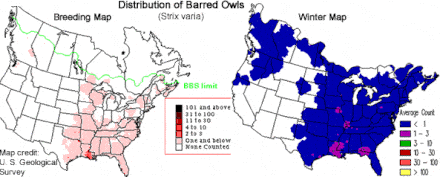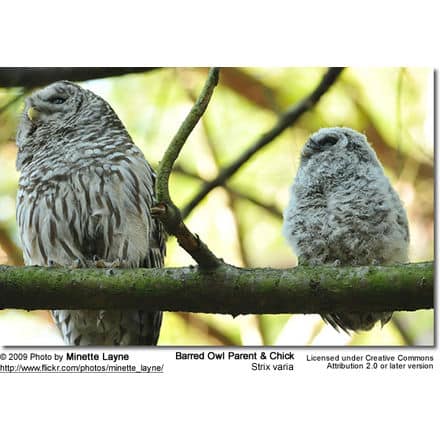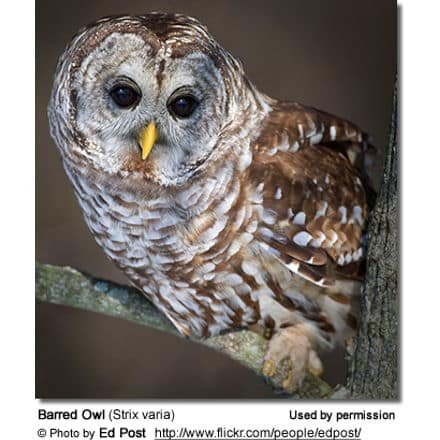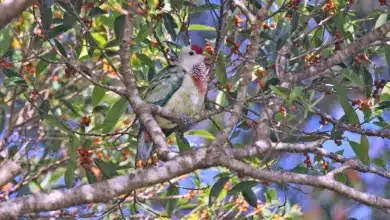Barred Owls: Subspecies, Range Map and Habitat
Distribution / Habitat
Barred Owl is most common in eastern United States west to Texas and their territory ranges north to southern Canada and south to Mexico.
During the 20th century, they have been expanding their range westward in the north of their range (probably as a result of habitat modifications in those regions), and are now found in southwestern Canada, Washington, Oregon and northern California.
Their expansion may be a result of loss of habitat within their historic range due to conversion of woodlands for residential and agricultural purposes or possibly man-made changes in the west have created new suitable habitat.
They are now displacing the closely related, smaller and less aggressive Northern Spotted Owls native to Washington, Oregon and California. Some interbreeding has occurred and the resulting hybrids are known as “Sparred Owls” or “Botted Owls”.
They are generally maintaining and aggressively defending breeding / feeding territories ranging in size from 213 – 903 acres (85 – 365 hectares).
They occur at elevations from sea level to 8,000+ feet (2,540 meters+) in Mexico.
They are generally permanent resident; however, may wander after the breeding season.
These owls are generally solitary, only occurring in pairs or small family groups during the breeding season. If disturbed, they will call to other members of their flock.
Barred owls live alone for most of the year, only living in family groups from the breeding season until the young leave the nest.
Outside the breeding season, mated pairs will live in adjoining home ranges and during the nesting season, the degree of overlap between their territories increases.
In Saskatchewan, Canada breeding home ranges have been recorded to be smaller than non-breeding home ranges, from 368 acres / 149 hectares (breeding) to 3,049 acres / 1,234 hectares (non-breeding).
One plausible reason for this is that pairs want to remain close to their nests.

Habitat
Barred Owls are generally found in large blocks of dense, old-growth forests and woodlands near bodies of water or wetland areas, such as wooded swamps; and always near open country for hunting.
They have also adapted well to human-modified habitats.
One of their main habitat requirements are large trees with dense foliage for daytime roosting and cavities for nesting.
Subspecies and Ranges:
- (Northern) Barred Owl (Strix varia varia – Barton, 1799) – Nominate Race
- Range: The most widespread form. Southwestern Canada south to northern California and east to Nova Scotia, and south to central and eastern USA, including southern and northern Texas and North Carolina). Possibly occurs as far north as Southeastern Alaska.
- Texas Barred Owl(Strix varia albogilva or helveola / helveolum – Bangs, 1899)
- Range: Southern Texas.
- Florida Barred OwlStrix varia georgica Latham, 1801
- Range: Southeastern USA, from Florida north to Georgia and west to Eastern Texas.
- Mexican Barred Owl(Strix varia sartorii / Strix sartorii – Ridgway, 1874)
- Range: Resident in the mountains of Mexico, from the state of Durango located in Northwest Mexico south to the state of Oaxaca situated in in Southwestern Mexico.

More Owl Information
- Owl Information
- Index of Owl Species with Pictures
- Owl Eyes / Vision Adaptations
- Pygmy Owls
- Barn Owls
- Horned Owls
- Scops Owls






